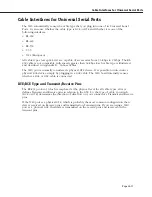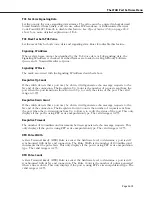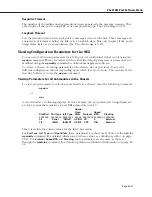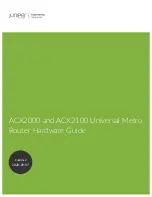
Loopback Detection
Page 28-13
Loopback Detection
Loopback Detection is a common method for Carrier Service Providers to test clients’ circuits
in the event of suspected line transmission problems. For both Frame Relay and PPP, loop-
back detection involves periodically transmitting a message and looking for that message to
be received. When implementing Loopback Detection, it is important to keep two issues in
mind: the message must not violate any standards; the message must be unique in such a way
that it can be differentiated from a message sent by a remote node.
The messages are transmitted in one of two fixed intervals. When the port is in normal mode,
the message is transmitted once every second. When two consecutive messages are received
that match the transmitted message, the port is considered to be in loopback. Once in loop-
back mode, the message is transmitted once every 100 milliseconds. After ten consecutive
messages are transmitted without receiving a match, the port is returned to normal mode.
Consequently, it takes up to 2 seconds to detect the loopback condition and an additional
second to exit it.
The message sent on a Frame Relay port uses standard 1490 encapsulation with a SNAP
header. The OUI (Organizationally Unique Identifier) of the SNAP header is the Alcatel OUI,
so encapsulation is standard, but the message is proprietary. The message is transmitted using
the lowest available DLCI, or 32 if there are no DLCI's operating on the port. Because the
message is merely attempting to determine the state of the physical port, the state of the
DLCI, whether active, inactive or non-existent, is not important; the Frame Relay switch will
discard any data for non-existent or inactive DLCIs.
The message sent on a PPP port uses the standard LCP Echo message.
Uniqueness of messages is accomplished by including a word in the message that is based
upon the configuration of the port and a free-running timer. For PPP, uniqueness is enhanced
by negotiating the LCP magic number option.
Summary of Contents for Omni Switch/Router
Page 1: ...Part No 060166 10 Rev C March 2005 Omni Switch Router User Manual Release 4 5 www alcatel com ...
Page 4: ...page iv ...
Page 110: ...WAN Modules Page 3 40 ...
Page 156: ...UI Table Filtering Using Search and Filter Commands Page 4 46 ...
Page 164: ...Using ZMODEM Page 5 8 ...
Page 186: ...Displaying and Setting the Swap State Page 6 22 ...
Page 202: ...Creating a New File System Page 7 16 ...
Page 270: ...Displaying Secure Access Entries in the MPM Log Page 10 14 ...
Page 430: ...OmniChannel Page 15 16 ...
Page 496: ...Configuring Source Route to Transparent Bridging Page 17 48 ...
Page 542: ...Dissimilar LAN Switching Capabilities Page 18 46 ...
Page 646: ...Application Example DHCP Policies Page 20 30 ...
Page 660: ...GMAP Page 21 14 ...
Page 710: ...Viewing the Virtual Interface of Multicast VLANs Page 23 16 ...
Page 722: ...Application Example 5 Page 24 12 ...
Page 788: ...Viewing UDP Relay Statistics Page 26 24 ...
Page 872: ...The WAN Port Software Menu Page 28 46 ...
Page 960: ...Deleting a PPP Entity Page 30 22 ...
Page 978: ...Displaying Link Status Page 31 18 ...
Page 988: ...Displaying ISDN Configuration Entry Status Page 32 10 ...
Page 1024: ...Backup Services Commands Page 34 14 ...
Page 1062: ...Diagnostic Test Cable Schematics Page 36 24 ...
Page 1072: ...Configuring a Switch with an MPX Page A 10 ...
Page 1086: ...Page B 14 ...
Page 1100: ...Page I 14 Index ...
















































